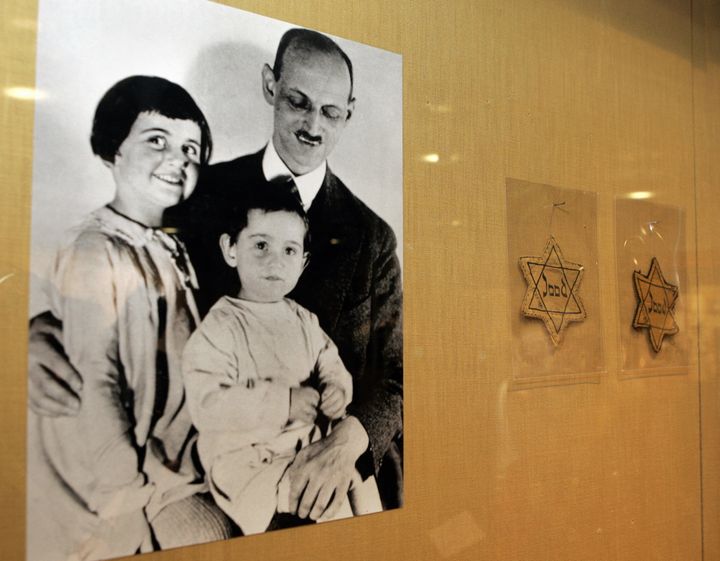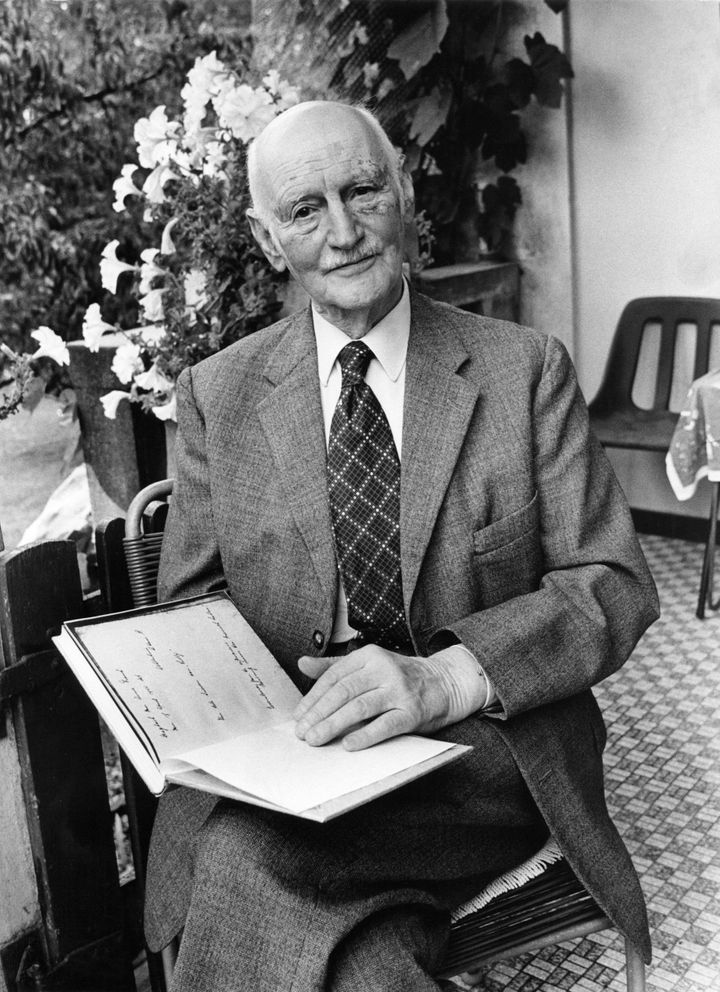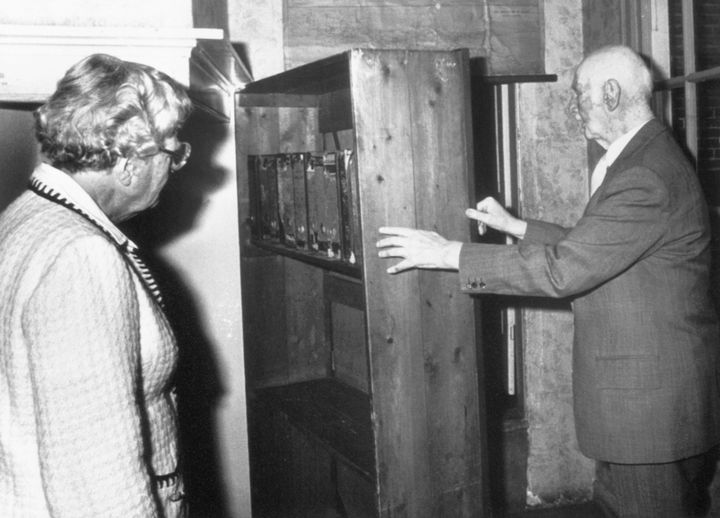Long before German Jewish businessman Otto Frank became known throughout the world as the father of the acclaimed Holocaust writer Anne Frank, he was just another refugee desperately seeking safety for his family in America.
A new report from the Anne Frank House in Amsterdam and the U.S. Holocaust Memorial Museum in Washington documents Otto Frank’s two unsuccessful attempts to obtain U.S. visas for his family. Without them, the Franks remained in the Nazi-occupied Netherlands, where they were all eventually arrested ― including Anne, the budding writer, who died in Germany’s Bergen-Belsen concentration camp in 1945.
The report was released by the two organizations on Friday, exactly 76 years after the Frank family went into hiding in Amsterdam.
A spokesperson for the USHMM told HuffPost that by July 1942, “it was clear that Otto’s efforts to get to the U.S. would not succeed in time to avoid Nazi genocidal policies.”

Otto Frank, a German Jew, relocated his family to Amsterdam in 1933, as Nazi leaders passed increasingly restrictive laws regulating all aspects of life for Jews in Germany.
Gertjan Broek, a researcher at the Anne Frank House, and Rebecca Erbelding from the USHMM wrote in their report that Otto Frank began seeking ways to escape to the U.S. as early as 1938.
At the time, the U.S. had no specific refugee policy. The government enforced stringent national origin quotas, restricting the number of people from each country who could immigrate to the U.S. per year. People fleeing persecution had to clear the same bureaucratic hurdles that all other immigrants faced, such as obtaining birth and wedding certificates, affidavits of support from family members in the U.S., medical records, letters from employers and tax documents.
Immigrants were also required to collect exit visas from their countries of residence. In 1941 the Nazis stripped German Jews living outside Germany of their nationality, which meant that those who had fled to other countries — like the Franks — were rendered stateless.
The Hebrew Immigrant Aid Society, a Jewish nonprofit that helps resettle refugees, said there are parallels between the policies that kept the Franks from finding refuge in the U.S. and the immigration policies adopted by Donald Trump’s administration.
Melanie Nezer, an HIAS senior vice president for public affairs, pointed to the extreme vetting procedures the White House has called for and Trump’s travel ban, which suspended the refugee resettlement program.
“These nationality-based bans echo the policies that kept people from German-occupied countries out of the United States beginning in 1941,” she told HuffPost via email. “Even though they were not explicitly the target of these policies, Jews were particularly impacted by them.”

After the outbreak of World War II, the U.S. government became increasingly concerned with the possibility of spies and saboteurs immigrating to the U.S., the researchers wrote. In 1941, the State Department decided that applicants with close relatives in German-occupied countries would no longer be eligible for visas. State Department officials were instructed to scrutinize every application even more carefully and reject anyone about whom they had any doubts.
At the same time, U.S. citizens had largely negative views of refugees overall. According to the report, a May 1938 public opinion poll found that 67 percent of Americans surveyed said they wanted to keep German, Austrian and “other political refugees” out of the United States. A Gallup poll conducted in June 1940 found that 71 percent of respondents said they believed that Nazi Germany had established a network of spies and saboteurs in the United States.
Even President Franklin D. Roosevelt warned that some Jewish refugees had been coerced to spy for the Nazis.
“National security took precedence over humanitarian concerns,” Broek and Erbelding wrote.

Meanwhile in Europe, the situation was getting dire for Jewish families. In November of 1938, the year that Otto Frank started trying to immigrate to the U.S., Nazi supporters terrorized Jews throughout the Third Reich in what came to be known as Kristallnacht — the Night of Broken Glass, so named because of the windows of Jewish homes, businesses and synagogues shattered in a wave of violence.
Frank turned to Nathan Straus, an affluent American businessman and friend from college, for help to immigrate to the U.S. In an April 1941 letter to Straus, Frank wrote that he had filed an application at the U.S. consulate in Rotterdam in 1938. But in 1940, while the Franks were waiting for their applications to move forward, that consulate ― and their application papers ― were destroyed in a German bombardment.
In 1941, Frank again tried to relocate to the U.S. He told Straus that he felt America was the only place his family could be safe.
“I am forced to look out for emigration and as far as I can see USA is the only country we could go to,” Frank wrote in the April letter.

But his hopes of moving to the U.S. were dashed by the end of June that year. After the U.S. ordered the closure of all German consulates in the U.S., Germany ordered the closure of all U.S. consulates in Nazi-controlled territory, including the Netherlands. As a result, moving the U.S. was no longer a viable option.
The researchers found no evidence to suggest that Frank was ever interviewed by a U.S. consular official, which means the family was not denied immigration visas.
Frank later turned his attention to Cuba, hoping to use the country as a “jumping board” to the U.S., the report reads. But that visa application was canceled in December 1941 for unclear reasons.

The Franks went into hiding in Amsterdam on July 6, 1942, and were later joined by another Jewish family, the van Pelses, and one more individual. They remained in the secret annex for more than two years, during which Anne kept her famous diary. The group was discovered on Aug. 9, 1944, and deported to various concentration camps.
The researchers wrote that Otto Frank’s efforts to flee to safety were “thwarted by American bureaucracy, war, and time.”
“The conclusion must be that both the Frank and van Pels families’ attempts were not successful because of the rapidly growing numbers of applicants for a small number of openings on the quota lists; the unwillingness of the president, State Department and Congress (or the American people) to open immigration beyond the limits set by the 1924 quota laws or to endeavor to fill these quotas; and, eventually, the impact of the war on the possibility of escape,” Broek and Erbelding wrote in the report.
Otto Frank was the only member of the family who survived the war. He published Anne’s diary in 1947, and it has gone on to be translated into dozens of languages.
Nezer said in her email that modern domestic and international refugee policies were a direct response to the Holocaust and the refugee crisis created by World War II, with U.S. laws and international treaties in place to help refugees and asylum seekers.
But she said the Trump administration’s immigration policies and the language it uses to “dehumanize” refugees are setting back decades of progress in refugee resettlement.
“Regardless of what our leaders say, Americans of faith, and particularly Jewish Americans, understand the importance of the United States as a safe haven for refugees,” Nezer said. “It would be a tragic mistake to reverse course and repeat the mistakes of the past. We are a strong country when we save people who are in harm’s way. We become weak when we reject them and let fear win.”
